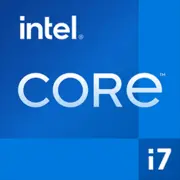Intel Core i7-13650HX

Intel Core i7-13650HX: Raptor Lake Power for Mobile Devices
March 2025
Modern laptops demand a balance between performance and energy efficiency. In this review, we will analyze the Intel Core i7-13650HX processor—the flagship chip for gaming and professional laptops. Why is it still relevant in 2025, and who is it suitable for? Let's find out.
1. Architecture and Process Technology: Hybrid Power of Raptor Lake
The i7-13650HX processor is built on the Raptor Lake architecture (13th generation Intel) using the Intel 7 process (10nm Enhanced SuperFin). It features a hybrid structure combining two types of cores:
- 6 Performance Cores (P-cores) with Hyper-Threading support (12 threads).
- 8 Efficient Cores (E-cores) without Hyper-Threading (8 threads).
Total: 14 cores and 20 threads.
Clock Speeds:
- Base: 2.6 GHz.
- Turbo Boost Max 3.0: up to 4.8 GHz (for P-cores).
- E-cores operate at speeds of up to 3.6 GHz.
Cache Memory:
- L3 Cache — 24 MB, enhancing performance in multi-threaded tasks such as rendering or video encoding.
Integrated Graphics (iGPU):
- Intel UHD Graphics for the 13th generation (32 EUs, 1.45 GHz).
- Supports 4K/60 Hz, AV1 decoding.
- For gaming and demanding tasks, a discrete graphics card (like RTX 4060/4070) will be required.
Architecture Features:
- Support for DDR5-5600 and PCIe 5.0 (up to 16 lanes).
- Intel Thread Director technology for optimizing workloads between P and E cores.
2. Power Consumption and TDP: Price for Performance
TDP (Thermal Design Power): 55 W. However, in Turbo mode, the processor can consume up to 157 W, which is typical for the HX series. This requires a robust cooling system:
- Gaming laptops use 3-4 heat pipes and high static pressure fans.
- Workstations feature liquid cooling (for example, in Dell Precision models).
Energy Efficiency:
- In idle mode or office tasks, the chip downclocks to 1.2 GHz, reducing power consumption to 15-20 W.
- Intel Speed Shift and Dynamic Tuning 3.0 technologies adapt the workload in real-time.
3. Performance: From Office to AAA Gaming
Geekbench 6:
- Single-Core: 2561 (comparable to Ryzen 9 7940HS).
- Multi-Core: 12773 (18% higher than i7-12650HX).
Real-World Scenarios:
- Office Work: Smooth multitasking with 20+ Chrome tabs, Excel spreadsheets, and Zoom—without lag.
- Multimedia: Rendering 4K video in Premiere Pro takes 8-10 minutes (compared to 12-14 minutes for i7-12650HX).
- Gaming: Paired with RTX 4070, it achieves 90-120 FPS in Cyberpunk 2077 (Ultra, DLSS Quality).
Turbo Mode:
- Under load, the processor maintains frequencies between 4.5-4.8 GHz for 3-5 minutes before stabilizing at 4.2 GHz (at temperatures up to 95°C).
4. Use Cases: Who is the i7-13650HX Suitable For?
- Gamers: For gaming with discrete graphics (RTX 4060 and above).
- Professionals: Video editors, 3D designers, programmers.
- Enthusiasts: Those working with virtualization (Docker, VM) or AI models.
Examples of Laptops:
- MSI Raider GE78HX ($2300): 32 GB DDR5, RTX 4070, 240 Hz display.
- Lenovo Legion Pro 7i ($1900): 16 GB DDR5, RTX 4060, ColdFront 5.0 cooling.
5. Battery Life: The Cost of Power
With a TDP of 55 W, don’t expect miracles from the battery:
- Under load (gaming, rendering), the laptop lasts 1.5-2 hours on mains power.
- In office mode (50% brightness, Wi-Fi) — 4-5 hours (with a battery capacity of 80-90 Wh).
Power-Saving Technologies:
- Intel Dynamic Tuning: Adapts consumption based on tasks.
- Optimus: Switches between iGPU and discrete graphics.
6. Comparison with Competitors
- AMD Ryzen 9 7940HS (Zen 4): Better in single-threaded tasks (Geekbench 6 Single-Core: 2689) but weaker in multi-threaded (12100).
- Apple M3 Pro (3 nm): More energy-efficient (18 hours of battery life) but limited in gaming and Windows software.
- Intel Core i9-13900HX: 10-15% more powerful but more expensive ($300-500 price difference in laptops).
7. Pros and Cons
Strengths:
- Exceptional multi-threaded performance.
- Support for DDR5 and PCIe 5.0 (relevant for NVMe SSDs 10 GB/s).
- Optimization for Windows 11 and professional software.
Weaknesses:
- High heat output (requires a substantial cooler).
- Short battery life.
- iGPU is weak for gaming without a discrete card.
8. Recommendations for Laptop Selection
- Gaming Models: Look for options with RTX 4070, displays over 144 Hz, and 16+ GB DDR5.
- Workstations: Pay attention to ISV certification (for AutoCAD, SolidWorks).
- Cooling: Check reviews for noise levels and temperatures under load.
Budget: Laptops with the i7-13650HX cost between $1500-2500. The best deals of 2025:
- HP Omen 17t ($1600): Basic configuration with RTX 4060.
- ASUS ROG Strix Scar 16 ($2100): Mini-LED display, 32 GB RAM.
9. Final Conclusion
The Intel Core i7-13650HX is the choice for those who need maximum performance in a mobile format. This processor is for:
- Gamers looking to play at 1440p without compromises.
- Professionals working with demanding applications.
- Those willing to sacrifice battery life for power.
Key Benefits: Future-proof architecture, support for the latest memory and SSD standards, and the possibility of upgrading to 128 GB of RAM. If you are looking for a laptop that will last for years, the i7-13650HX will justify the investment.
Basic
CPU Specifications
Memory Specifications
GPU Specifications
Miscellaneous
Benchmarks
Compared to Other CPU
Share in social media
Or Link To Us
<a href="https://cputronic.com/cpu/intel-core-i7-13650hx" target="_blank">Intel Core i7-13650HX</a>



